Windows Image Designer Tool Download
The best image compression tools
When you're looking to boost your website's performance, some would recommend you jump straight into a detailed analysis of each page: the HTTP requests you're making, any redirects involved, the position of scripts and style sheets, and more.
But while there's no doubt that examining these issues can help, it's important to consider the basics first. In particular, are you sure that any graphics you're using are fully optimised for the web?
You've probably already made sure to choose the appropriate format for each image as well as keeping its size (in pixels) to a minimum. Maybe you've reduced the JPEG quality setting as much as you can. (Although if you're not quite confident in your knowledge of the fundamentals then the Designer's Guide to Image Compression may help.)
The unfortunate reality is that, no matter how carefully you design your images, the graphics tool you're using will not save the finished files in the most efficient way. And so passing those images through a compression tool can reduce their size considerably.
Exactly how much you can save is tricky to say for sure as it depends very much on your source graphics. Some JPGs may only drop by 50-100 bytes. It's not unusual for regular web graphics to be compressed by 10-40%, though, with no loss of image quality (and lossy compression techniques, perhaps reducing colours or reencoding JPEGs can cut file sizes even more).
Testing
Which programs are the best, then? Good question. To help provide an answer we've pitched 18 of the top contenders against each other.
The bulk of these are Windows-based lossless compression tools as they're the most interesting (reducing file size without reducing image quality is a very appealing idea). But we've also included lossy compression options, Mac programs and web services, so there really is something here for everyone.
We then asked every package to compress the same sets of GIF, PNG and JPG images, each of which were actual web graphics we'd found on a range of real sites, and made a note of the savings.
We checked the programs for other issues, too. Were they easy to use? How fast was the compression process? And how reliable? Could a program sometimes increase an image size, for instance?
And the results were very interesting and often a real surprise. Keep reading to find out what we discovered.
The programs
1. AdvanceCOMP 1.15
Platform: Windows
An ancient command line tool with the minimum of help, AdvanceCOMP isn't exactly going to appeal to the average PC user.
If you're not put off by batch files, though, it's easy to use.
A simple line like 'for %a in ("C:\PNG File\Folder\*.png") do advpng -z -4 "%a"', for instance, will cause the program to apply its lossless compression algorithm to every file in your folder, replacing the original with a (hopefully) smaller version.
However, the end results are disappointing with our test PNG web graphics dropping by an average of 14.2% (only one tool here did worse).
That is of course considerably better than doing nothing at all, though. And if you want to combine several tools together to get the maximum PNG compression then AdvanceCOMP may be able to play a part.
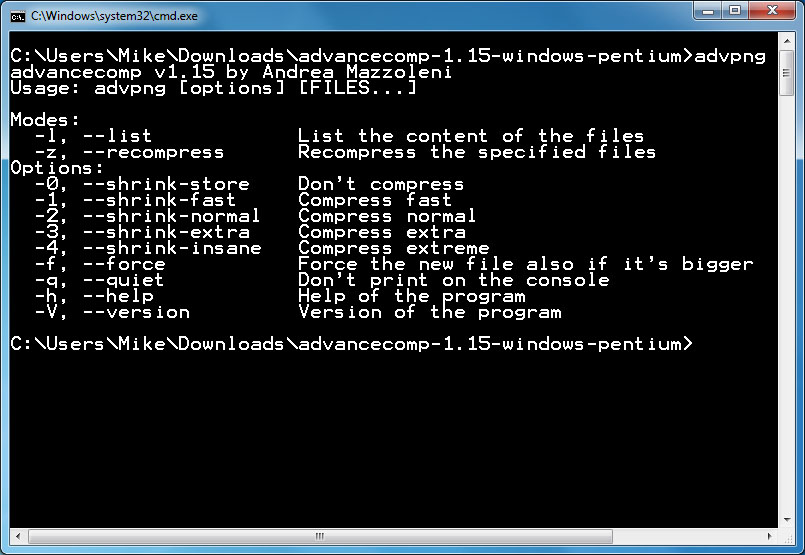
2. Caesium 1.4.1
Platform: Windows
Caesium is a simple open source tool that helps you to compress PNG, JPG and BMP formats.
It's an easy program to use. Click the Add program, choose your images, select an Output folder, click Compress and you'll have your results within seconds.
BMP compression isn't of interest to us, and the program's JPG technology isn't anything special, either. There's no lossless option; it just reencodes the file at your chosen quality setting.
Caesium does provide support lossless PNG compression, although this has a major limitation. It can only output 24-bit files, so if you're using anything else then your images will probably grow in size.
And the program's results clearly illustrated the problem, with most of our test PNG web graphics actually increasing in size. Fortunately, you can tell Caesium not to write a file in that case. But even then the overall size of our images fell by a very feeble 1.2%. Clearly most people will be better off elsewhere.
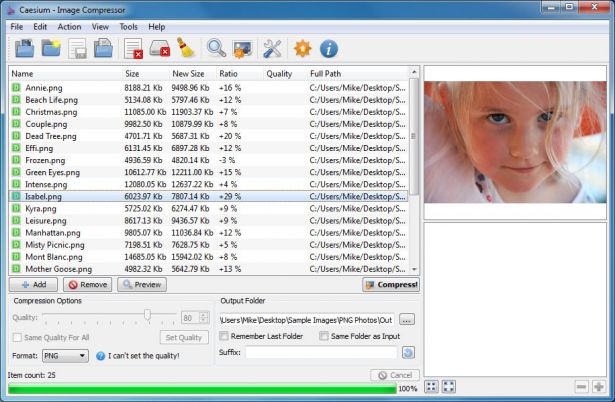
3. FILEminimizer Pictures 3.0
Platform: Windows
FILEminimizer Pictures takes a more drastic approach to image compression than most of the competition. By default it may change formats, resize images, re-encode JPEGs with a reduced quality and strip out metadata in an effort to shrink your pictures. Although, fortunately, you can adjust most of this in the program's settings.
In use, the program follows the usual format. Once you've pointed it to your source files, chosen an output folder, perhaps configured an option or two, one click is enough to begin optimisation. And it's fairly quick, so you're not kept in suspense for very long.
How well does it do? That varied depending on format - at least for our tests. PNG compression rates were nothing special at 26.8% (some lossless tools do better); GIF compression was a more average 16.5%; but our JPG web graphics dropped in size by 39.3%, the largest fall in this group.
Whether this sort of reduction is enough to justify compromising image quality is another matter. FILEminimizer Pictures program is versatile, configurable and easy to use, though, and if that's more your priority then it may be worth trying the program for yourself.
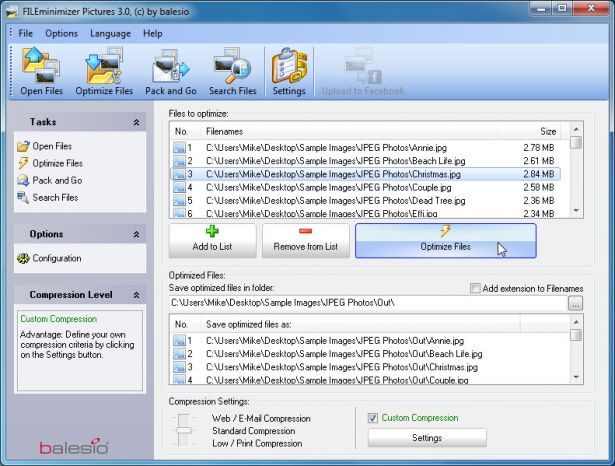
4. FileOptimizer 2.10.135
Platform: Windows
There's no doubting FileOptimizer's ambition. Not only can it compress JPG, GIF and PNG images, but it can also work with executable files, archives, Microsoft Office documents, PDF files, and the list goes on.
Surprisingly, though, there's no increase in complexity. In fact, the program has one of the most straightforward interfaces here: drag and drop your images onto FileOptimizer, right-click, choose Optimize and that's it.
This simplicity has a down side as your source files are replaced by the program. The originals are sent to the Recycle Bin so remain recoverable, for a while at least. But this could be a problem.
Of course it's compression that really matters and here is where FileOptimizer delivers some great results.
For instance, the program shrank our PNG test graphics by 42.2% - the best lossless compression performance in this group. JPEG and GIF compression rates were more standard at 17.7% and 15.9% respectively, but there's still a lot to like about FileOptimizer especially if you can also use it to compress other downloads on your site.
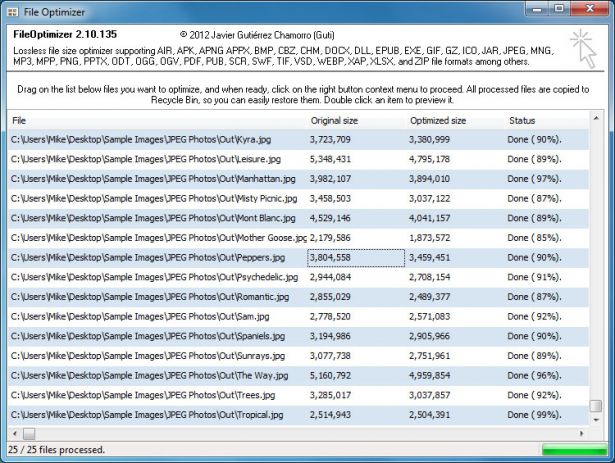
5. ImageOptim 1.4.0
Platform: Mac
ImageOptim is a Mac tool that optimises GIF, JPEG and PNG images by acting as a front end for a host of other applications: PNGOUT, AdvPNG, Pngcrush, extended OptiPNG, JpegOptim, jpegrescan, jpegtran, and Gifsicle.
The program is all about lossless compression - removing comments, colour profiles and so on - rather than re-encoding or reducing the number of colours. As a result it won't cut file sizes by quite as much as some of the competition, but at least you don't have to worry about any loss in image quality.
ImageOptim's front end works well, too. Drag on a single file, a group, a folder or whatever, and it immediately starts compressing each image and displaying the results. The program isn't the fastest tool around, but unless you're giving it thousands of HD JPEGs that's probably not going to be a problem.
The end results were solid, but not spectacular. Our GIF web graphics were reduced in size by 16.2%, PNG's by 17.8%, JPGs by 18.3%.
You can do better elsewhere with individual tools, then. But if you just want a single, simple Mac-based tool, which can handle GIFs, JPEGs and PNG files, then ImageOptim looks like a very sensible choice.

6. JPEGmini Lite 1.4.1
Platform: Mac
JPEGmini is an interesting Mac app with a two-pronged approach to shrinking JPEGs.
First, it uses a smart algorithm to figure out how much an image can be compressed without visible effects (so the program isn't lossless, but it's not just re-encoding at some fixed quality setting, too).
And then the program uses its own JPEG encoder to try and deliver the most compact files possible.
There's plenty going on in the background, but none of this is visible to the user. Just drag and drop your pictures onto the program (a maximum of 20 per day in the free version) and it'll replace the originals with compressed versions.
The results here can vary greatly. Our JPG web graphics saw little reduction, 8.2%, but when we presented the program with 25 large digital photos they dropped by 71.3% and with little obvious quality loss.
For simple web graphics JPEGmini doesn't do anything too amazing. The compression possibilities ramp up considerably as your images get larger. If your graphics are on the bulky side then it's definitely worth giving the program a trial to see how it works for you.
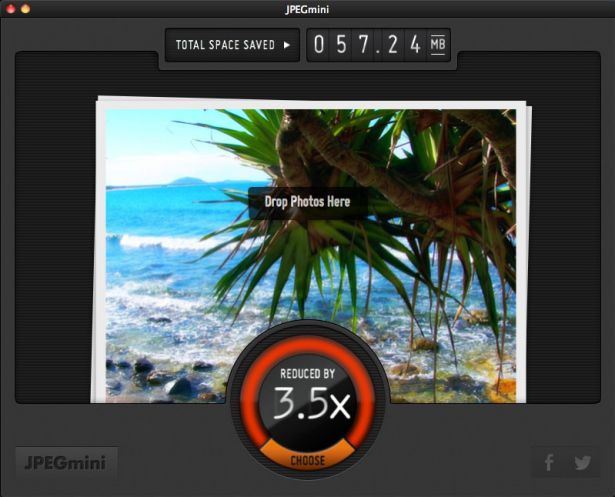
7. jStrip 3.3
Platform: Windows
jStrip is a lossless compression tool for JPEG files, which removes non-essential information: thumbnails, comments, colour profiles, extra bytes at the beginning or end of the file, and assorted other bits and pieces.
The data lost per file will generally be small as there's no re-encoding. This was particularly noticeable when we presented JStrip with some high resolution JPG photos. Those files were so large that the program could only reduce the size by around 1%.
If the files you're looking to compress are already small, though, the waste is likely to be far more significant. And sure enough, when we passed our sample JPEG web graphics through jStrip, they fell in size by an average of 16.1%.
The program isn't perfect. By default it will replace the images you specify with compressed versions, for instance, so you'll need to remember to work with copies. But otherwise jStrip is a quick and easy way to marginally reduce the size of your JPEG images.
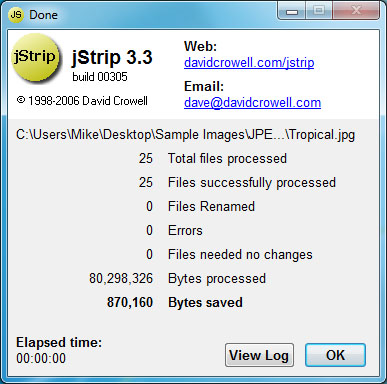
8. OptiPNG 0.7.3
Platform: Windows
OptiPNG is a popular command line-based lossless PNG compression tool, regularly reused within other packages (such as PNGGauntlet, see later) to handle optimisation tasks for them.
The program is a little better documented than many similar packages, so don't necessarily be put off by its command line nature. The download comes with a PDF file explaining its various switches and options, for instance, which is helpful (although you'll still need plenty of image optimisation experience to fully understand this).
And the results, even with the default compression settings, seem to be very acceptable with our test PNG web graphics dropping in size by a chunky 32.2% on average.
If you're looking for an easy life, then PNGGauntlet provides a simpler, GUI-based way to try the program (and better overall compression). But if you're looking to combine a number of command line tools to deliver the best possible results then OptiPNG may be worth including.
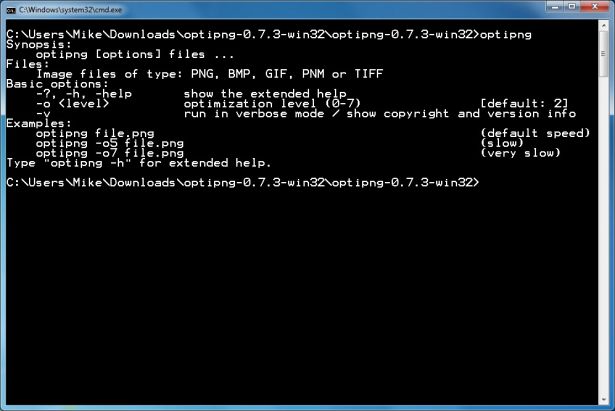
9. PNGGauntlet 3.1.2.0
Platform: Windows
PNGGauntlet is an interesting tool, essentially a frontend for three other open source programs (PNGOUT, OptiPNG, DeflOpt) which do the real compression work.
In operation it works much like the competition. Drag and drop in your source images, choose an output folder, click the "Optimize!" button and wait.
And wait, and wait, and wait, maybe. Presumably because it combines the work of three tools, PNGGauntlet can be extremely slow, taking 50:44 to compress 25 hi-res photos in the PNG format.
The results are impressive, though. In our PNG Web Graphic test, the program shrank our 50 images by an average of 41.3% and even the photos dropped by 7.75%.
Is this really enough to justify the performance issues? We're not sure, but if you need a quality PNG compression tool then PNGGauntlet really should be on your shortlist.
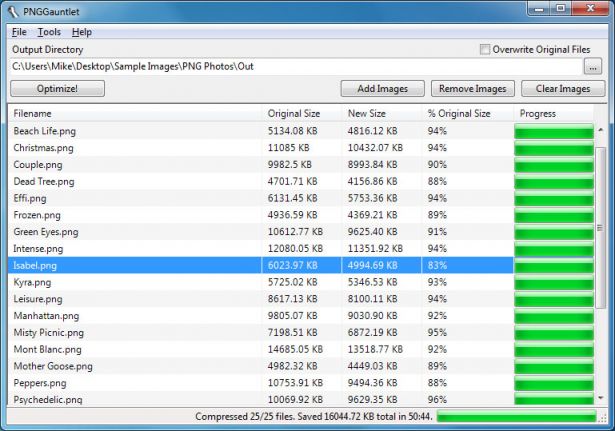
10. PNGOptimizer 2.2
Platform: Windows
At a tiny 146KB download, PNGOptimizer is the smallest program here, so it's no real surprise that the interface is a little basic. Or that it concentrates on PNG files.
You do get a surprising number of compression options, though. PNGOptimizer can remove interlacing, for instance; keep, remote or replace the background colour; and remove text or the image's physical dimensions in pixels.
And the program can even import GIF, BMP or TGA files, saving them to PNG according to your chosen options.
You still don't get the more advanced options available with some of the competition and that was visible in our test results. PNGOptimizer only stripped an average 3.6% off our hi-res PNG photos.
The program did much better on web graphics, though, achieving an average 39.8% compression rate. If you just want a small and simple PNG-crunching tool then PNGOptimizer may be good enough.
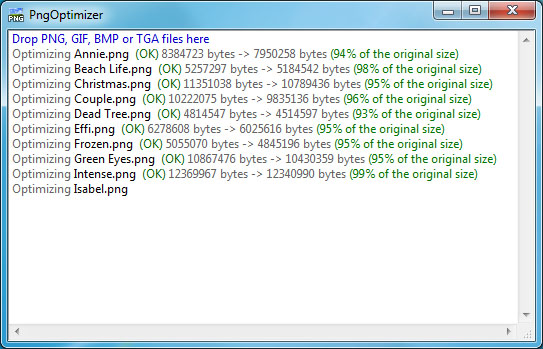
11. PNGOUTWin 1.5.0
Platform: Windows
PNGOUT is one of the best image compression tools around. Unfortunately, it's also rather awkward to use, being command-line based and with no batch processing support. But if that's a problem then you could always opt for its commercial frontend, PNGOUTWin.
The program is highly configurable. You can use PNGOUTWin to overwrite your original images, or save its output to a new folder. And there are options to preserve file times, adjust its compression level, optionally keep some (or all) PNG chunks, and more.
It's also easy to use. Drag and drop your images onto the program window and it immediately starts the compression process, using multiple threads to work on several images at the same time.
And the results are also excellent; our PNG web graphics were reduced in size by 40.5% (not bad at all for lossless compression).
Unfortunately for the author, there are now free PNGOUT frontends, such as PNGGauntlet, which also make it very easy to use the program (and actually achieve even better compression levels by combining it with other tools). And so, while PNGOUTWin is an impressive tool, it's probably not worth the $14.95 (personal licence)/ $29.95 (corporate) asking price.
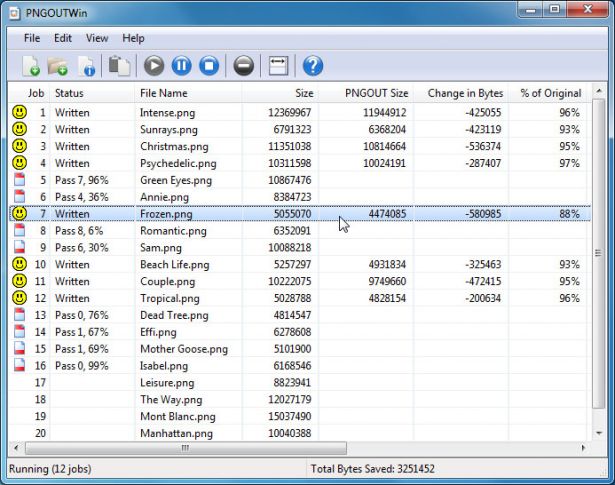
12. PUNYpng
Platform: web
Far more versatile than its name suggests, PUNYpng is a web service that can actually apply lossless compression to GIF and JPG images, as well as PNGs and you can open an account for free, too. It's a little restrictive; you can only upload 15 images in a batch, each no more than 150KB in size.
Although, if that's not an issue, it's simple to use. Click an Upload Images button on the site, then wait as the pictures are uploaded and compressed. A report explains what's happened and you can download the full set as a ZIP file.
The free account applies lossless compression only. PUNYpng delivers capable results here and typically reduced our various test file sets by between 16 and 32%.
But pay from $2 a month and you can upgrade to a PRO account, which adds a lossy compression option and allows you to upload more and larger files.
Is it worth it? We still prefer the convenience of client software. If you need a web service, though, and won't be affected by the restrictions, PUNYpng is both effective and easy to use.
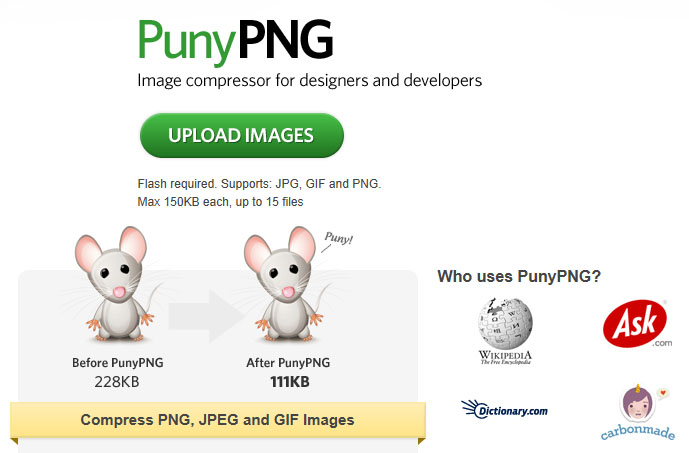
13. RIOT 0.4.6
Platform: Windows
While RIOT is free, it's one of the only programs here which will attempt to install additional software during the setup process. Be sure to clear the relevant checkbox during installation if you're not interested.
But with that hassle out of the way, everything else is very straightforward. A clean and clear interface makes it easy to compress individual GIF, PNG or JPG images and compare the results while a batch interface processes multiple files at very high speeds.
Unfortunately, what you're not getting here is lossless compression. RIOT is more about reducing the number of colours in your image, re-encoding JPEGs with a lower quality value, and so on.
Despite this, the program still managed to make some of our test images considerably larger. (You'll need to check RIOT's output carefully before you use it.)
The program still did well, though, in particular with our GIFs, which it managed to reduce by an average of 42.8%. Its extreme configurability mean RIOT deserves a closer look.
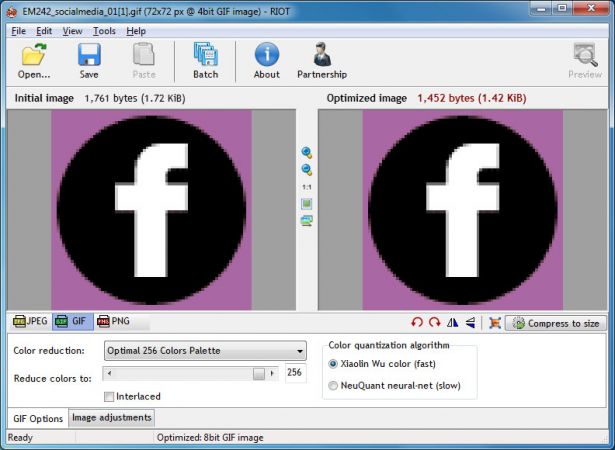
14. ScriptJPG
Platform: Windows
ScriptJPG is one of the more primitive packages here, being essentially just a Windows script that acts as a front end to several command line tools. Drag and drop your JPGs onto the script, choose your compression options (either lossless or a particular JPEG quality setting) and ScriptJPG will cut down the images for you.
That's the plan, anyway. For some reason, tt didn't work as advertised with our JPG web graphics and never even displaying the starting menu. We've no idea why and, of course, one problem with ScriptJPG's rather basic approach is you don't get any helpful error messages.
We were able to test the package on our JPEG photos and here the script was fairly successful. Its lossless compression option cut the size of our images by almost 10%.
If you're the technical type then ScriptJPG may be of interest. You can diagnose problems as they crop up and perhaps edit the script, customising the compression parameters to suit your own needs.
If you prefer an easy life, though, we'd stick with one of the GUI-based equivalents. There are plenty of more powerful alternatives and, of course, they're much simpler to use, too.
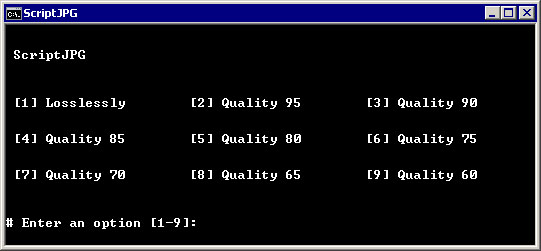
15. ScriptPNG
Platform: Windows
As you've probably already guessed from the name, ScriptPNG is the cousin of ScriptJPG: a Windows batch file that uses four utilities to cut your PNG files down to size.
As with ScriptJPG, it's a very bare-bones approach. Drag and drop your images onto the file and a command prompt opens with nine possible compression options. Choose the one you need and the program is off, crunching each file in turn (and replacing the original images with the output, so make sure you have a copy).
An additional problem we had is that pngout.exe kept crashing. The script didn't seem to care, but we were forced to manually close the error dialog every time it happened.
For all that, compression results were impressive. Our PNG Web Graphics lost up to 40.1% of the bulk.
We still prefer a more full-featured optimisation tool, on balance. But there's no doubt that the scripting approach does give you a huge amount of control. If you don't like something ScriptPNG does, or want to add some new tool or option, just edit the file accordingly.
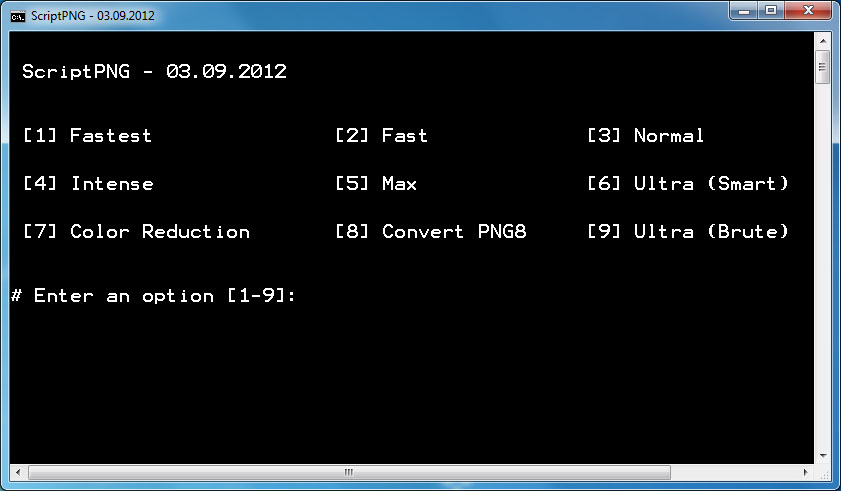
16. Smush.It
Platform: web
Most image compression web services are heavily restricted, but Yahoo's Smush.It is a rare exception. You're limited to files of up to 1MB in size, yes, but otherwise the system will upload as many images as you need. There's no registration, no account creation, no daily quotas. Images are crunched them with a variety of tools, allowing you to download the results in a ZIP file.
If there's one problem with this approach it's that you're very isolated from compression tools themselves. You can't configure or tweak them in any way. The results you see are what you get and there's nothing whatsoever you can do to change them.
That's something of an issue with JPGs as Smush.It only managed to reduce our test images by around 1%.
PNG compression was more effective at 35.3%, though, while our GIFs lost an impressive 23.9% (the best lossless compression performance here).
On balance we still prefer the freedom and configurability of a local tool, but if the convenience of an online service suits your needs then Smush.It may be a sensible choice.
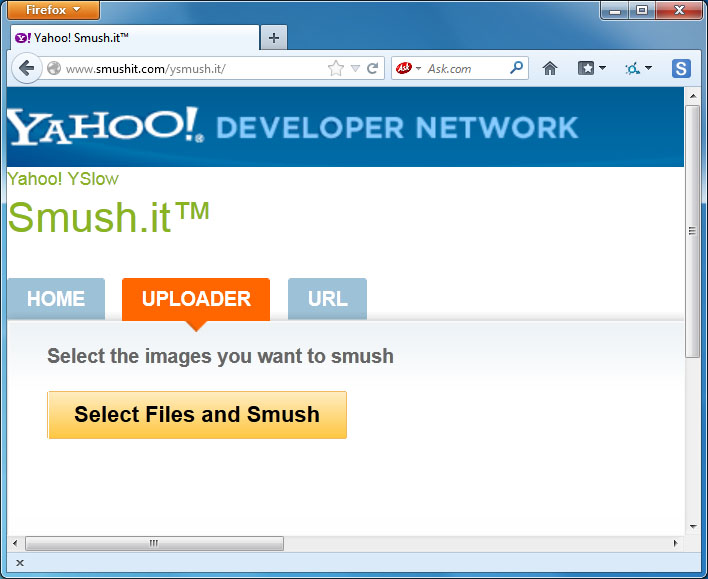
17. TinyPNG
Platform: web
Similar to Smush.It, TinyPNG is a free web service that can optimise images for you. Just drag and drop your files onto the web page, it'll compress them at speed and provide links for downloading.
The system has some annoyances. The 2MB file size limit isn't too bad, but you can only upload 20 files at one time, and you must then manually download each one in turn, which isn't a good idea.
TinyPNG also takes a distinctly more lossy approach to compression than most of the other tools here by reworking the palette to reduce (sometimes dramatically) the number of colours in use.
Unsurprisingly, this pays off in terms of the raw figures, with the service compacting our PNG web graphics by a mighty 48% - the best in this test. And in most cases you'll find it very difficult to spot any difference between the source images and compressed versions.
The best of our lossless tools also managed compression rates of over 40%, though. And so if image quality is your top priority - or you just don't want to always be comparing graphics, trying to see if there's any difference - then one of TinyPNG's better competitors may be a better deal.
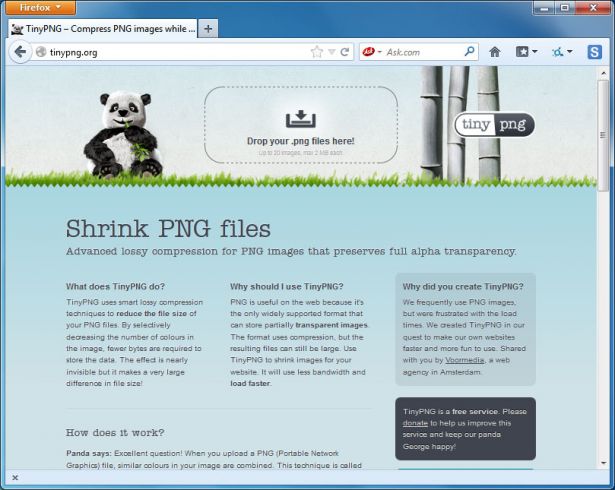
18. Trout's GIF Optimizer 2.3
Platform: Windows
Trout's GIF Optimizer is another very small and portable compression tool. No installation is required; just unzip the download and it's ready to go.
Features are a little limited, though. As you'll guess from the name, the program is only about GIF compression and there are no global configuration options of interest (although you can manually optimise the palette of individual images in a variety of ways).
Still, this does at least make Trout's GIF Optimizer very easy to run. Just import your chosen photos, the size reduction achieved for each image is displayed right away (it's very fast), and you can save them with just a few clicks.
But, unfortunately, this doesn't make for particularly impressive compression results: our GIF web graphics only shrank by an average of only 16.7%.
If you're happy to take the time to manually explore the colour palette options for individual images then Trout's GIF Optimizer may be worth a try, but most people are likely to achieve better results with another tool.
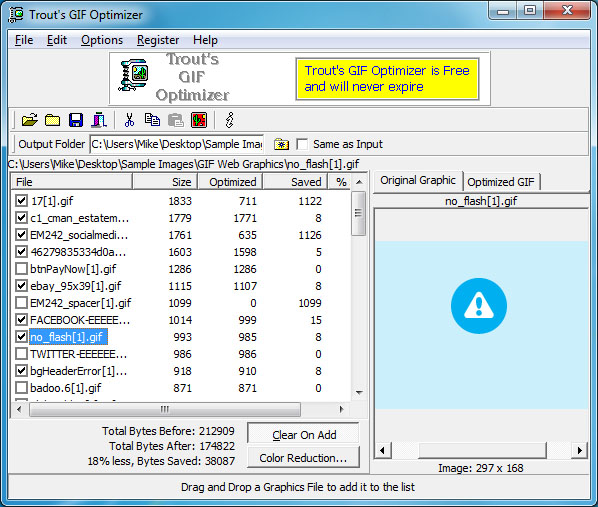
The results
| AdvanceComp 1.15 | Windows | Lossless | -14.20% | ||
| Caesium 1.4.1 | Windows | Lossy / lossless | +18.7% | ||
| FILEminimizer 3.0 | Windows | Lossy / lossless | -26.8% | -39.3% | -16.5% |
| FileOptimizer 2.10.135 | Windows | Lossless | -42.2% | -17.7% | -15.9% |
| ImageOptim 1.4.0 | Mac | Lossless | -17.8% | -18.3% | -16.2% |
| JPEGmini Lite 1.4.1 | Mac | Lossless | -8.2% | ||
| jStrip 3.3 | Windows | Lossless | -16.1% | ||
| OptiPNG 0.7.3 | Windows | Lossless | -32.3% | ||
| PNGGauntlet 3.1.2.0 | Windows | Lossless | -41.3% | ||
| PNGOptimizer 2.2 | Windows | Lossy / lossless | -39.8% | ||
| PNGOutWin 1.5.0 | Windows | Lossless | -40.5% | ||
| PUNYpng | Web | Lossless | -32.1% | -27.5% | -16.1% |
| RIOT 0.4.6 | Windows | Lossy | -21.7% | -39% | -42.8% |
| ScriptJPG | Windows | Lossy / Lossless | Failed | ||
| ScriptPNG | Windows | Lossless | -40.1% | ||
| Smush.It | Web | Lossless | -35.3% | -1% | -23.9% |
| TinyPNG | Web | Lossy | -48% | ||
| Trout's GIF Optimizer 2.3 | Windows | Lossy / lossless | -16.7% |
Conclusion
After many hours of testing, benchmarking and generally putting our contenders through the paces, one lesson was very clear: image compression really can discover significant and very worthwhile results.
Our PNG test files were routinely reduced by 30 to 40%, for instance, and even our JPEGs could be cut in size by 16-18%. This was all using lossless compression, so there's no reduction in image quality; the files look exactly the same, but just load more quickly.
The exact results you'll see may vary considerably, of course. But if you've not tried anything similar before then it's definitely worth taking the best of our programs for a trial just to see what they can do for you.
Which tools should you choose? FileOptimizer delivered the best all-round lossless performance under Windows, with an excellent 42.2% compression rate for our test PNG files, very capable JPG and GIF results, and some other useful options thrown in (PDF compression, for instance).
But if the program doesn't work for you, PNGGauntlet and ScriptPNG also delivered great PNG compression, and ImageOptim for the Mac managed useful JPEG and GIF compressions rates.
And, although we found our test web services to be less convenient to use, don't rule them out entirely. PUNYpng was the best lossless JPG compressor here, while Smush.It trampled over the GIF competition, and both could be a great help in cutting your own web graphics down to size.
Related articles
Windows Image Designer Tool Download
Source: https://www.creativebloq.com/netmag/best-image-compression-tools-1135828
Posted by: cordersolloond.blogspot.com

0 Response to "Windows Image Designer Tool Download"
Post a Comment